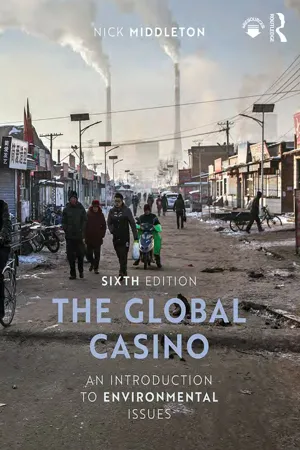
The Global Casino
An Introduction to Environmental Issues
Nick Middleton
- 648 pagine
- English
- ePUB (disponibile sull'app)
- Disponibile su iOS e Android
The Global Casino
An Introduction to Environmental Issues
Nick Middleton
Informazioni sul libro
The Global Casino is an introduction to environmental issues which deals both with the workings of the physical environment and with the political, economic and social frameworks in which the issues occur. Using examples from all over the world, the book highlights the underlying causes behind environmental problems, the human actions which have made them issues, and the hopes for solutions. It is a book about the human impact on the environment and the ways in which the natural environment impacts human society.
The sixth edition has been fully revised and updated throughout, with new case studies, figures, and online resources including a complete lecture course for tutors and multiple-choice questions for students. New concepts and topics covered for the first time in this edition include the green economy, the forest transition model, marine microplastic pollution, urban disasters, decommissioning of big dams, and the start of the Anthropocene. Recent international initiatives covered include the Paris Agreement on climate change, the Aichi Biodiversity Targets, and the Sendai Framework for managing disaster risk. New case studies include Morocco's Noor concentrated solar power plant, desert recovery in Kuwait, and river management on the Huang Ho.
Eighteen chapters on key issues follow three initial chapters which outline the background contexts of the physical and human environments and the concept of sustainable development. Each chapter provides historical context for key issues, outlines why they have arisen, and highlights areas of controversy and uncertainty to appraise how issues can be resolved both technically and in political and economic frameworks. Each chapter also contains an updated critical guide to further reading – many of them open access – and websites, as well as discussion points and essay questions. The text can be read in its entirety or individual chapters adopted as standalone reading.
This book is an essential resource for students of the environment, geography, earth sciences and development studies. It provides comprehensive and inspirational coverage of all the major global environmental issues of the day in a style that is clear and critical.
Domande frequenti
Informazioni
CHAPTER 1
The physical environment
- Appreciate some of the key ways we classify the natural world by identifying units, such as biomes.
- Understand how the natural world works through the recognition of cycles, such as the hydrological cycle.
- Appreciate the importance of scale (both time and space).
- Recognize that the state of our knowledge of the natural world is imperfect.
- Understand that our sources of data include direct and indirect methods of measurement.
- Appreciate that a scientific approach to environmental change is dominant but it is by no means the only kind of knowledge about how our planet works.
Classifying the Natural World
| Ecosystem type | Mean net primary productivity (g C/m2/year) | Total net primary production (billion tonnes/C/year) |
|---|---|---|
| Tropical rain forest | 900 | 15.3 |
| Tropical seasonal forest | 675 | 5.1 |
| Temperate evergreen forest | 585 | 2.9 |
| Temperate deciduous forest | 540 | 3.8 |
| Boreal forest | 360 | 4.3 |
| Woodland and shrubland | 270 | 2.2 |
| Savanna | 315 | 4.7 |
| Temperate grassland | 225 | 2.0 |
| Tundra and alpine | 65 | 0.5 |
| Desert scrub | 32 | 0.6 |
| Rock, ice and sand | 1.5 | 0.04 |
| Agricultural land | 290 | 4.1 |
| Swamp and marsh | 1125 | 2.2 |
| Lake and stream | 225 | 0.6 |
| Total iand | 324* | 48.3 |
| Open ocean | 57 | 18.9 |
| Upweiling zones | 225 | 0.1 |
| Continental shelf | 162 | 4.3 |
| Algal bed and reef | 900 | 0.5 |
| Estuaries | 810 | 1.1 |
| Total oceans | 69* | 24.9 |
| Total for biosphere | 144* | 73.2 |
Source: after Whittaker and Likens (1973).

- tundra
- coniferous forest (also known as boreal forest or taiga)
- temperate forest
- tropical rain forest
- tropical savanna
- temperate grassland
- desert
- maquis (also known as chaparral).
Indice dei contenuti
- Cover
- Title
- Copyright
- Contents
- list of figures
- List of tables
- Preface
- Acknowledgements
- 1 The physical environment
- 2 The human environment
- 3 Sustainable development
- 4 Tropical deforestation
- 5 Desertification
- 6 Oceans
- 7 Coastal issues
- 8 Rivers, lakes and wetlands
- 9 Big dams
- 10 Urban environments
- 11 Climatic change
- 12 Acidification
- 13 Food production
- 14 Soil erosion
- 15 Biodiversity loss
- 16 Transport
- 17 Waste management
- 18 Energy production
- 19 Mining
- 20 Warfare
- 21 Natural hazards
- 22 Conclusions
- Glossary
- Bibliography
- Index